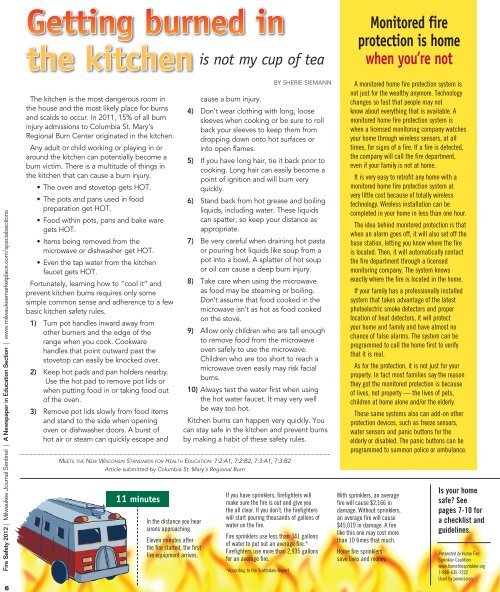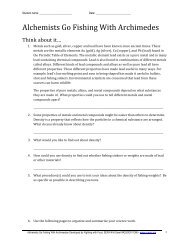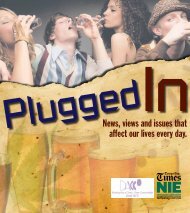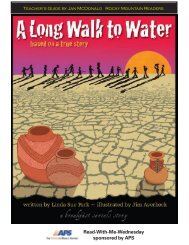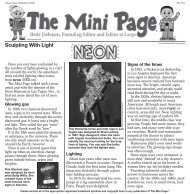Download the Fire Safety Section PDF - Newspapers In Education
Download the Fire Safety Section PDF - Newspapers In Education
Download the Fire Safety Section PDF - Newspapers In Education
You also want an ePaper? Increase the reach of your titles
YUMPU automatically turns print PDFs into web optimized ePapers that Google loves.
<strong>Fire</strong> <strong>Safety</strong> 2012 | Milwaukee Journal Sentinel | A Newspaper in <strong>Education</strong> <strong>Section</strong> | www.milwaukeemarketplace.com/specialsections<br />
6<br />
Getting burned in<br />
<strong>the</strong> kitchen<br />
The kitchen is <strong>the</strong> most dangerous room in<br />
<strong>the</strong> house and <strong>the</strong> most likely place for burns<br />
and scalds to occur. <strong>In</strong> 2011, 15% of all burn<br />
injury admissions to Columbia St. Mary’s<br />
Regional Burn Center originated in <strong>the</strong> kitchen.<br />
Any adult or child working or playing in or<br />
around <strong>the</strong> kitchen can potentially become a<br />
burn victim. There is a multitude of things in<br />
<strong>the</strong> kitchen that can cause a burn injury.<br />
• The oven and stovetop gets HOT.<br />
• The pots and pans used in food<br />
preparation get HOT.<br />
• Food within pots, pans and bake ware<br />
gets HOT.<br />
• Items being removed from <strong>the</strong><br />
microwave or dishwasher get HOT.<br />
• Even <strong>the</strong> tap water from <strong>the</strong> kitchen<br />
faucet gets HOT.<br />
Fortunately, learning how to “cool it” and<br />
prevent kitchen burns requires only some<br />
simple common sense and adherence to a few<br />
basic kitchen safety rules.<br />
1) Turn pot handles inward away from<br />
o<strong>the</strong>r burners and <strong>the</strong> edge of <strong>the</strong><br />
range when you cook. Cookware<br />
handles that point outward past <strong>the</strong><br />
stovetop can easily be knocked over.<br />
2) Keep hot pads and pan holders nearby.<br />
Use <strong>the</strong> hot pad to remove pot lids or<br />
when putting food in or taking food out<br />
of <strong>the</strong> oven.<br />
3) Remove pot lids slowly from food items<br />
and stand to <strong>the</strong> side when opening<br />
oven or dishwasher doors. A burst of<br />
hot air or steam can quickly escape and<br />
...........................................................................................................................................................................................................................................<br />
Meets <strong>the</strong> New wiscoNsiN staNdards for health educatioN: 7:2:a1, 7:2:B2, 7:3:a1, 7:3:B2<br />
Article submitted by Columbia St. Mary’s Regional Burn<br />
11 minutes<br />
<strong>In</strong> <strong>the</strong> distance you hear<br />
sirens approaching.<br />
Eleven minutes after<br />
<strong>the</strong> fire started, <strong>the</strong> first<br />
fire equipment arrives.<br />
is not my cup of tea<br />
cause a burn injury.<br />
If you have sprinklers, firefighters will<br />
make sure <strong>the</strong> fire is out and give you<br />
<strong>the</strong> all clear. If you don’t, <strong>the</strong> firefighters<br />
will start pouring thousands of gallons of<br />
water on <strong>the</strong> fire.<br />
<strong>Fire</strong> sprinklers use less than 341 gallons<br />
of water to put out an average fire.*<br />
<strong>Fire</strong>fighters use more than 2,935 gallons<br />
for an average fire.<br />
*According to <strong>the</strong> Scottsdale Report<br />
By Sherie Siemann<br />
4) Don’t wear clothing with long, loose<br />
sleeves when cooking or be sure to roll<br />
back your sleeves to keep <strong>the</strong>m from<br />
dropping down onto hot surfaces or<br />
into open flames.<br />
5) If you have long hair, tie it back prior to<br />
cooking. Long hair can easily become a<br />
point of ignition and will burn very<br />
quickly.<br />
6) Stand back from hot grease and boiling<br />
liquids, including water. These liquids<br />
can spatter, so keep your distance as<br />
appropriate.<br />
7) Be very careful when draining hot pasta<br />
or pouring hot liquids like soup from a<br />
pot into a bowl. A splatter of hot soup<br />
or oil can cause a deep burn injury.<br />
8) Take care when using <strong>the</strong> microwave<br />
as food may be steaming or boiling.<br />
Don’t assume that food cooked in <strong>the</strong><br />
microwave isn’t as hot as food cooked<br />
on <strong>the</strong> stove.<br />
9) Allow only children who are tall enough<br />
to remove food from <strong>the</strong> microwave<br />
oven safely to use <strong>the</strong> microwave.<br />
Children who are too short to reach a<br />
microwave oven easily may risk facial<br />
burns.<br />
10) Always test <strong>the</strong> water first when using<br />
<strong>the</strong> hot water faucet. It may very well<br />
be way too hot.<br />
Kitchen burns can happen very quickly. You<br />
can stay safe in <strong>the</strong> kitchen and prevent burns<br />
by making a habit of <strong>the</strong>se safety rules.<br />
Monitored fire<br />
protection is home<br />
when you’re not<br />
A monitored home fire protection system is<br />
not just for <strong>the</strong> wealthy anymore. Technology<br />
changes so fast that people may not<br />
know about everything that is available. A<br />
monitored home fire protection system is<br />
when a licensed monitoring company watches<br />
your home through wireless sensors, at all<br />
times, for signs of afire. If afire is detected,<br />
<strong>the</strong> company will call <strong>the</strong> fire department,<br />
even if your family is not at home.<br />
It is very easy to retrofit any home with a<br />
monitored home fire protection system at<br />
very little cost because of totally wireless<br />
technology. Wireless installation can be<br />
completed in your home in less than one hour.<br />
The idea behind monitored protection is that<br />
when an alarm goes off, it will also set off <strong>the</strong><br />
base station, letting you know where <strong>the</strong> fire<br />
is located. Then, it will automatically contact<br />
<strong>the</strong> fire department through alicensed<br />
monitoring company. The system knows<br />
exactly where <strong>the</strong> fire is located in <strong>the</strong> home.<br />
If your family has aprofessionally installed<br />
system that takes advantage of <strong>the</strong> latest<br />
photoelectric smoke detectors and proper<br />
location of heat detectors, it will protect<br />
your home and family and have almost no<br />
chance of false alarms. The system can be<br />
programmed to call <strong>the</strong> home first to verify<br />
that it is real.<br />
As for <strong>the</strong> protection, it is not just for your<br />
property. <strong>In</strong> fact most families say <strong>the</strong> reason<br />
<strong>the</strong>y got <strong>the</strong> monitored protection is because<br />
of lives, not property —<strong>the</strong> lives of pets,<br />
children at home alone and/or <strong>the</strong> elderly.<br />
These same systems also can add-on o<strong>the</strong>r<br />
protection devices, such as freeze sensors,<br />
water sensors and panic buttons for <strong>the</strong><br />
elderly or disabled. The panic buttons can be<br />
programmed to summon police or ambulance.<br />
With sprinklers, an average<br />
fire will cause $2,166 in<br />
damage. Without sprinklers,<br />
an average fire will cause<br />
$45,019 in damage. Afire<br />
like this one may cost more<br />
than 10 times that much.<br />
Home fire sprinklers<br />
save lives and money.<br />
Is your home<br />
safe? See<br />
pages 7-10 for<br />
a checklist and<br />
guidelines.<br />
Presented by Home <strong>Fire</strong><br />
Sprinkler Coalition<br />
www.homefiresprinkler.org<br />
1-888-635-7222<br />
Used by permission.


